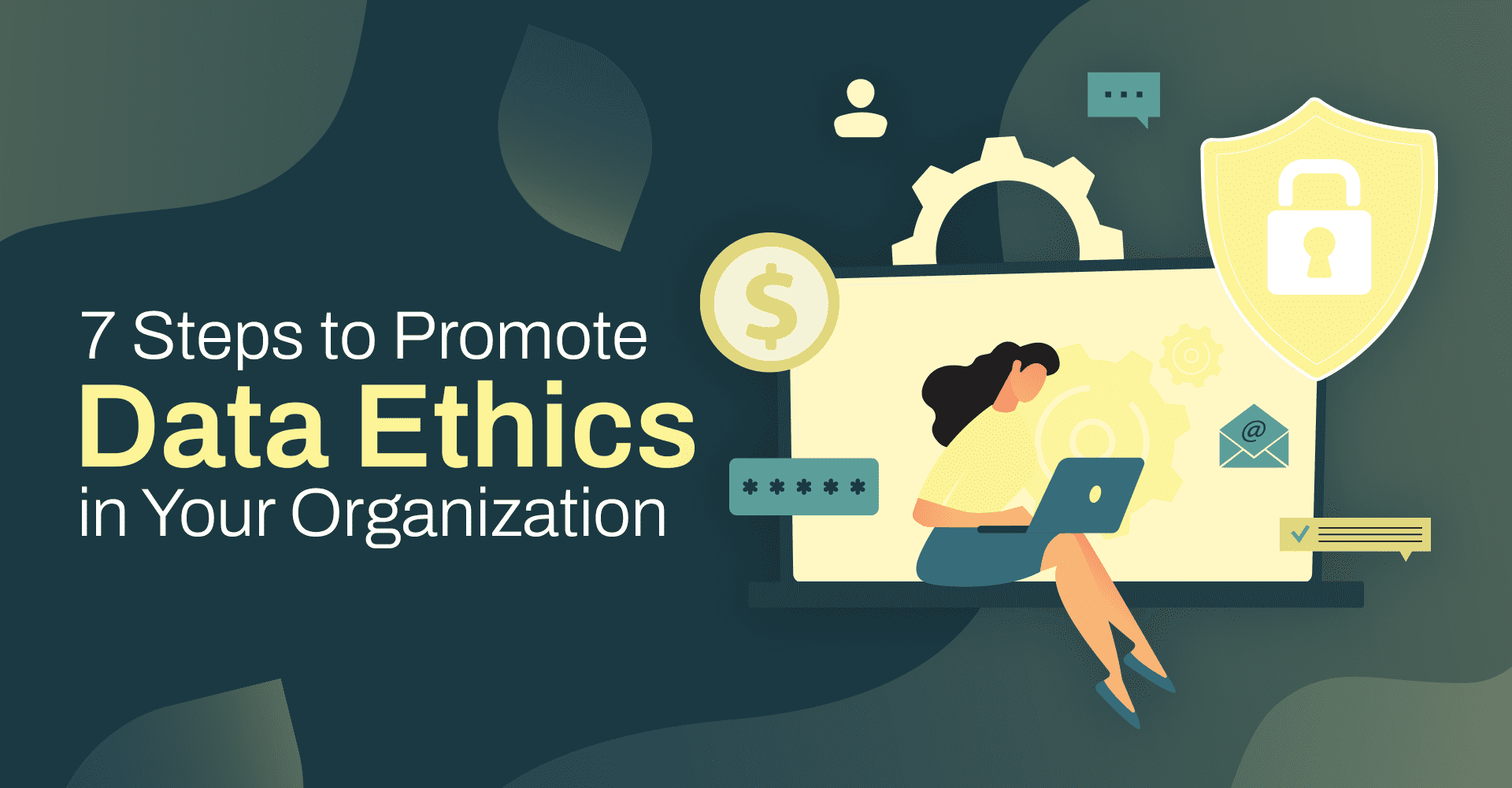7 Steps to Promote Data Ethics in Your Organization

Table of Contents
As organizations gather and utilize more private data than ever before, guaranteeing safe and ethical data use has become a main concern. Although implementing technical measures is crucial, it is not sufficient on its own.
Building a data-driven culture of protection is fundamental to guaranteeing the safe and ethical use of data. By prioritizing data privacy, investing in robust security measures, and regularly evaluating and enhancing privacy practices, organizations can protect sensitive data, build trust with stakeholders, and avoid potential legal and reputational risks by implementing these strategies.
Organizations must also establish clear policies and procedures for handling data, educate their employees, and promote a culture of transparency. In this regard, here are some essential strategies for ensuring safe and ethical data use:
- Developing a comprehensive privacy policy
- Educating employees
- Establishing a privacy team
- Conducting privacy impact assessments
- Implementing privacy-by-design
- Regularly reviewing and updating privacy practices
- Encouraging transparency
You can also generate a privacy policy using an online privacy policy generator.
Below, we explain 7 steps you can take to better safeguard personal data, build trust with customers and stakeholders, and demonstrate your commitment to ethical data handling practices.
Step 1. Develop a comprehensive privacy and data governance policy
To safeguard personal data, it’s essential to develop a comprehensive privacy and data governance policy. All aspects of data management, from data collection to storage and sharing, ought to be covered by this policy. It should clarify what kinds of data will be collected, why it will be collected, and how it will be used, saved, and shared.
Additionally, the policy must establish the obligations and accountabilities of the workforce and provide a framework for managing data breaches. It should also include provisions to ensure adherence to applicable data protection regulations, such as the General Data Protection Regulation (GDPR). Here’s an explanation of GDPR and why it’s important for your business.
For example, a healthcare facility might draft a privacy policy that specifies the personal data it collects from patients, such as their insurance data, contact data, and medical records. The policy should specify how this data is used, stored, and shared for research, medical treatment, and billing.
Noncompliance with the Health Insurance Portability and Accountability Act (HIPAA), which exists to protect sensitive patient information, can increase the risk of data breaches. Here are examples of HIPAA violations that can be easy to miss.
The first step in safeguarding data is being clear on how you gather and process information. Building a privacy policy is an essential component of this.
Step 2. Educate employees on privacy and data governance policies
Privacy is a fundamental right. It’s critical to educate employees on privacy and data governance. Consistent training helps ensure employees understand their obligations when handling personal data. Revise training regularly to keep up with changing data protection laws and regulations, and ensure it covers topics such as ethical data handling, data protection laws, and data governance policies.
By offering proper training, organizations can help ensure employees handle personal data in a reliable and ethical manner. For example, a financial services firm might provide its employees with frequent privacy training to ensure they are fully aware of current privacy regulations and laws. Training can focus on topics such as data encryption, access control, and network security.
Step 3. Establish a privacy and data governance team
Creating a privacy and data governance team is a valuable way to ensure privacy compliance and educate employees. The team should have members from various departments, including IT, legal, and compliance. They should be accountable for formulating and executing privacy and data governance policies and procedures, performing privacy impact assessments, and enforcing compliance with privacy laws and regulations.
To make data privacy a top priority, start by appointing a chief privacy officer who can oversee data privacy practices. They can also implement comprehensive data privacy policies, educate employees on data privacy best practices, and develop a privacy-conscious mindset.
Step 4. Conduct privacy impact assessments
It’s important to proactively identify potential privacy risks and mitigate them before implementing new systems or processes that involve personal data. Below are simple and easy-to-follow steps for conducting a data protection impact assessment:
- Determine the scope, purpose, and personal data of the project or program.
- Assess potential privacy risks and impacts, including risk likelihood and severity.
- Implement measures to mitigate data protection risks, and monitor and evaluate them on an ongoing basis.
- Engage relevant stakeholders and document the process and results of the data protection impact assessment.
A privacy impact assessment effectively evaluates the risks associated with the collection, use, and storage of personal data, identifies potential privacy risks, and develops strategies to mitigate those risks. Another type of assessment that helps in finding flaws in data protection is a penetration testing assessment.
Step 5. Implement privacy and data protection by design
Privacy by design is an approach to data protection where privacy features and protections are built in during the design phase rather than added as an afterthought. By incorporating privacy and data protection into the design of new systems, products, or services, organizations can help ensure that personal data is protected from the start.
Privacy by design involves considering privacy concerns throughout the lifecycle of a product or service, from initial design to final processing of personal data. This may include implementing technical safeguards such as encryption or access controls, or establishing policies and procedures to ensure that personal data is collected and used only for its intended purpose.
Implementing privacy by design can help organizations reduce the risk of data breaches and fines, and build trust with customers and stakeholders by demonstrating their commitment to protecting personal data.
Step 6. Regularly review and update privacy and data governance practices
Privacy laws and regulations are constantly evolving, so it’s essential for organizations to regularly review and update their privacy and data governance practices to stay up to date with changing requirements. This includes reviewing and updating policies and procedures, conducting regular audits and assessments, and ensuring that employees receive ongoing training on privacy and data governance issues.
Regularly reviewing and updating privacy and data governance practices can help organizations identify and address potential privacy risks before they become a problem. This can also demonstrate a commitment to protecting personal data and help build trust not only with customers but also with relevant stakeholders.
Step 7. Encourage transparency in privacy and data governance
Transparency is critical to privacy and data governance. Organizations should seek consent from individuals before collecting personal data, let them know what data will be collected and how it will be used or stored. Ensure all use of personal data is in line with the reasons it was collected. Conduct regular audits and assessments to ensure compliance with applicable data protection laws and regulations.
To promote transparency, implement ethical data use practices. Effective privacy and data governance policies protect individuals and ensure compliance. Transparency promotes ethical data use, and to achieve this it’s also important to train staff, establish data protection teams, conduct data protection impact assessments, and enforce data protection.
Conclusion
Data ethics is an essential task for any organization. Specialized measures are important, but they aren't sufficient on their own. For data use to be safe and ethical, it's important to implement clear programs and procedures, educate workers, and foster a culture of transparency.
By following the above guidelines, organizations can demonstrate their commitment to guarding data, avoid legal and reputational pitfalls, and build trust across the board.

Osman Husain
Osman is the content lead at Enzuzo. He has a background in data privacy management via a two-year role at ExpressVPN and extensive freelance work with cybersecurity and blockchain companies. Osman also holds an MBA from the Toronto Metropolitan University.
%20Post%202-jpg-2.jpeg?width=800&height=300&name=Mprgin_New%20Requests_800x300_MH_23-Feb-2023%20(CTA%20Banners)%20Post%202-jpg-2.jpeg)